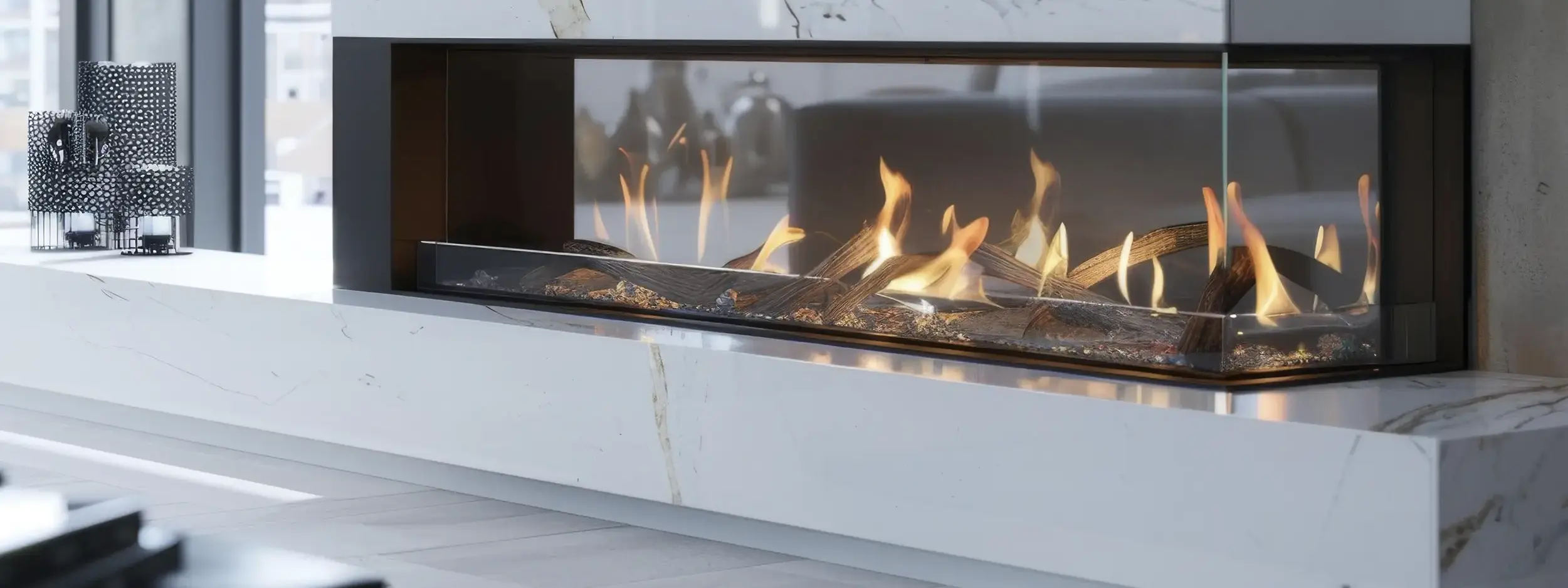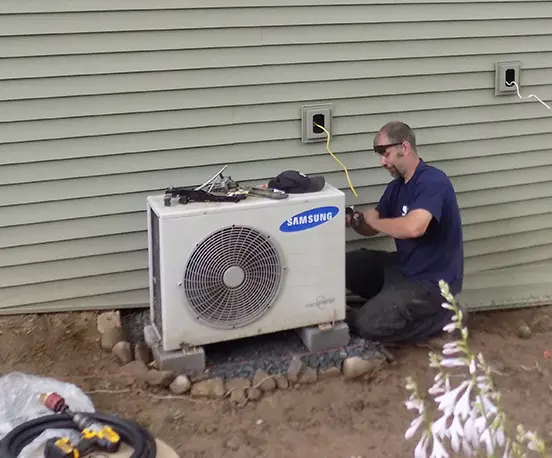Product Showcase
Combined Energy Services is proud to offer the purchase and installation of appliances and accessories that increase the heating efficiency and enhance the look of your home!
Learn more:

Space Heaters
Press ‘enter’ or click to see hidden content
Generally, space heaters are used to warm a small space, rather than a central heating system that conditions a larger area. Installed space heaters may use electricity or burn propane, fuel oil or wood pellets and may operate on heat pump principles.
Space heaters come in different types:
Direct Vent Wall Furnace
What is direct vent? In direct-vent appliances, you use special direct-vent pipe recommended by the supplier. The direct-vent system involved two parts: one part for the exhaust and one for combustion air intake. The appliances itself is a completely sealed combustion chamber and no air from the house is used for combustion. The exhaust vents can go either out through a sidewall or through the roof.
Pros: Combustion fumes are vented outside. Allows a simple installation in cases where the vent is going out a wall and terminates at the wall. No need to terminate above the roof line as is necessary with b-vent or wood burning applications resulting in relatively low venting costs. Direct-vent appliances are typically higher in efficiency than b-vent appliances and put out a lot of heat even with a low-flame setting.
Cons: Direct fireplaces have a sealed glass and typically a smaller flame than a b-vent fireplace or a vent-free fireplace. The position and look of the logs in the fireplace cannot be altered or incomplete combustion will occur. Direct vent wall furnaces come in a variety of models depending on your needs:
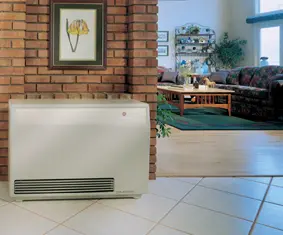
High Efficiency Direct-Vent Wall Furnace
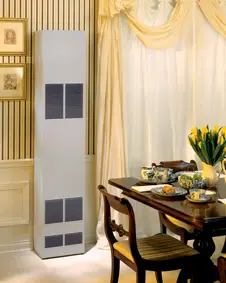
Counterflow Direct-Vent Wall Furnace
Vented Heaters
What is vented? Sometimes referred to as Natural Vent – B-Vent appliances use pipe (b-vent) that must be installed through the home and terminate above the roof. They also use room air for combustion, but the amount of air they use is minimal.
Pros: Combustion fumes are vented outside. B-vent pipe itself is relatively inexpensive and simple to install. B-vent appliances are relatively efficient.
Cons: B-vent must be installed through the interior of the home and terminate above the roof which may pose extensive installation labor costs or difficulties depending on the home. B-vent could potentially be a source of cool air into the living area if a downdraft occurs. Some of the heat from the appliance is lost up the vent.
Vented wall heaters come in a variety of models depending on your needs:
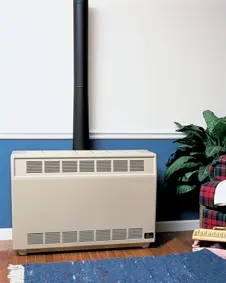
Vented Room Furnace
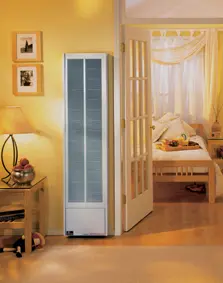
Counterflow Up-vent Wall Furnace
Vent Free Room Heaters
What is vent free? A vent-free uses no venting pipe at all which allows placement of the appliance in many places otherwise unavailable to a vented appliance. The burner of the fireplace or the appliance is designed to be 99%+ efficient, therefore there is no need to vent the appliance.
Pros: Ease of installation and lowered cost since vent pipe is not needed. Vent-free products are typically the most efficient of all appliances since all the heat is generated into the room or home.
Cons: Combustion fumes are vented inside the home which affect some people who are very sensitive to smell or allergies. Vent-free products expel a fair amount of moisture as a result of the burn process which is also expelled into the home and can be a problem especially in a room with a lot of windows like a sun-room since the windows may drip from all the moisture. Typically there is a low flame with vent-free products and the placement of the burner or logs are set by the manufacturer and cannot be changed or altered.
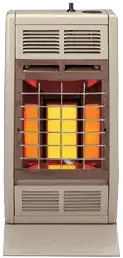
Radiant Heater
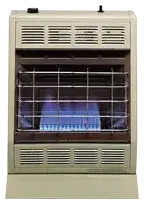
Blue Flame Heater
Gas Stove Heaters
With a gas stove you can create a warm gathering place that is clean and modern or timeless and traditional. Gas stoves have the ambiance of a freestanding woodstove but offer you the convenience of gas.
What are Gas Stoves? With a simple push of a button or flip of a switch, gas stoves come to life, instantaneously producing heat and a soothing atmosphere. Gas stoves allow homeowners to enjoy a realistic feel and look of a wood burning fuel without the hassles of chopping, splitting, or storing firewood.
Benefits of Gas Stoves: Gas stoves are extremely functional and require very little maintenance and cleaning. Plus, most directly vented units only require 3 to 4 sq. ft. to install, allowing them to be installed in small rooms or tight living spaces. Take advantage of the numerous benefits of gas stoves and invest in heating technology that will help reduce heating costs and make heating your home quickest.
We provide fireplace products from the following manufacturers:
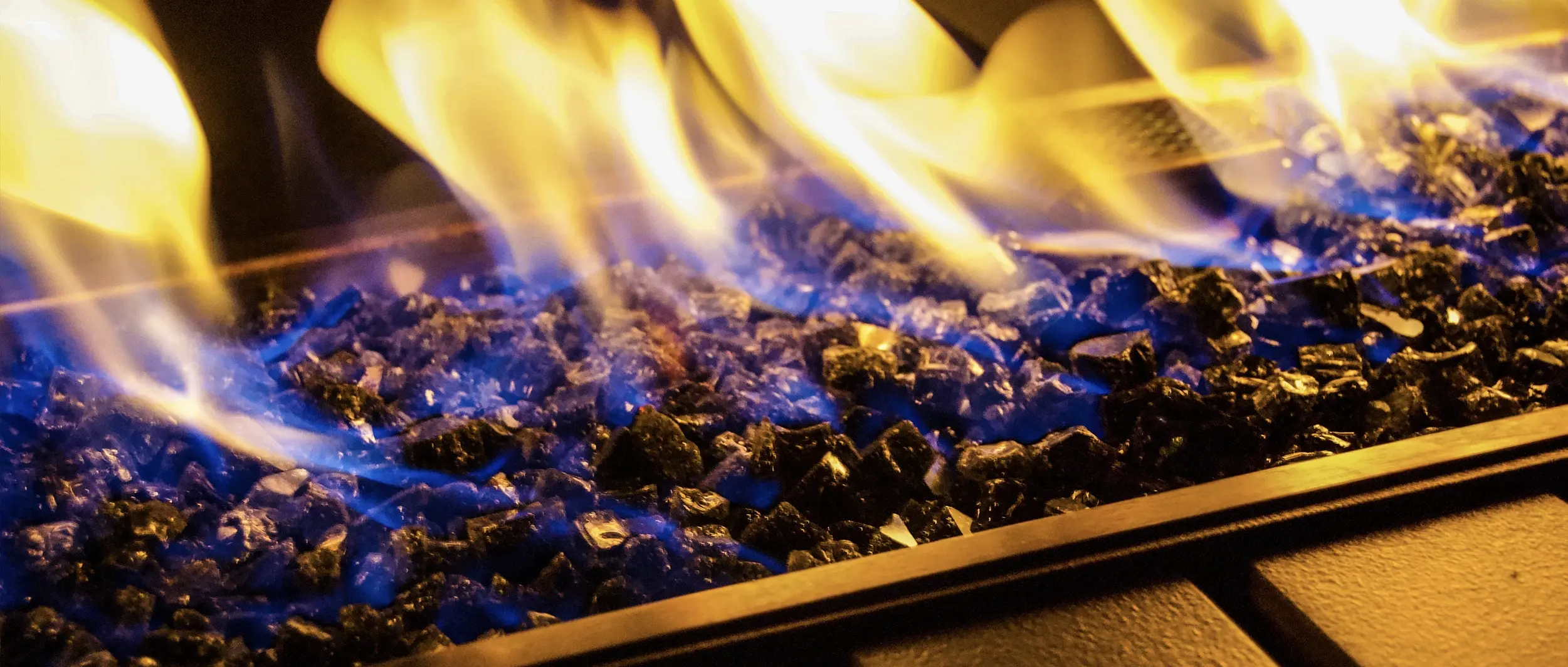
Fireplaces
Press ‘enter’ or click to see hidden content
Benefits of Gas Fireplaces
Gas fireplaces provide a reliable source of heat and add beauty to a room design. You have two basic options for a gas fuel fireplace – gas logs and gas fireplace insert. Both product heat and help a living space feel warm and inviting, but each has its own advantages and disadvantages. Gas fireplaces are less expensive than installing a wood-burning fireplace that requires a full-scale chimney to release smoke and ash.
Fireplace Aesthetics: One of the big differences between gas-log fireplaces and gas-insert fireplaces is aesthetic appeal. Even though gas logs are synthetic, they look similar to solid wood logs and appear more authentic than inserts. Vented gas logs can’t be covered with glass doors or solid grates, similar to natural wood-burning fireplaces. Gas inserts have a more manufactured design. You can see the flames inside the inserts, but they are permanently sealed with a glass face. Some manufacturers offer gas-inserts styles that have grates or doors, but they are for physical appearance only. Neither gas logs nor gas inserts create flames that crackle, pop or flicker.
Heat Efficiency: Gas inserts are more efficient than gas logs. Because gas inserts are covered in glass, they require less gas and therefore less heat escapes. According to NW Natural Appliance in Portland, Oregon, gas-log fireplaces are approximately 10% efficient and have similar efficiency ratings to wood-burning fireplaces. Vented gas-insert fireplaces are approximately 80% efficient.
Cost Comparisons: Unsurprisingly, the more efficient the fireplace, the lower the operating cost. NW Natural Appliance Center reports that in 2012, gas-log fireplaces cost between $.75 and $1.25 per hour to operate, depending on the size of the burner beneath the logs. Gas-insert fireplaces cost approximately 40 to 45 cents per hour. Fluctuating propane prices can affect those averages, but comparisons between gas-log and gas-insert operational costs remain the same. Gas inserts are more cost-effective than gas logs.
Lighting Methods and Chimney Requirements: You can light some gas-log fireplaces with a match. Others have a switch that ignites pilot light to start the flame. Lower-heat yellow-flame logs require vents, but some higher-heat blue flame logs don’t. Vented gas-log fireplaces have smoke and soot and require chimneys and chimney cleaning. Gas-insert fireplaces are only lit by a switch that ignites the burner. Vented gas-insert fireplaces also require chimneys, but small flexible heat-resistant pipes are generally sufficient, and there is less smoke and soot than with vented gas-log varieties.
Fireplace Options
Gas Fireplace Inserts
While the traditional masonry fireplace is great for aesthetics and adds to the “down home” atmosphere
of any home, the fact is that they are not much for actual heating. If you need heat for your home and
want to utilize your existing fireplace, you may be interested in a fireplace insert.
What is a Fireplace Insert? A fireplace insert is a closed-combustion firebox that is installed into an
existing fireplace to increase efficiency. You literally “insert” the unit into the old fireplace and instantly upgrade its efficiency and heating capabilities exponentially. Inserts are available for burning wood or burning gas.
Direct Vent vs. Vent Free: If you are certain you want to go with a gas insert, the decision then comes
down to whether direct vent or vent-free is right for you. The basic difference between the two is obvious; the direct vent units will require venting up to the chimney, while the vent-free inserts are entirely self-contained and do not require any additional components for operation. The other main distinction is that direct vent units will have a fixed glass panel sealing the unit off from the room, while the vent-free insert will be open to the room, using room air for combustion.
A Wise Investment: Choosing the perfect fireplace insert can be challenging, but the result is rewarding. You will turn your old, drafty masonry fireplace into an aesthetically-pleasing. Your living room will be transformed and you may find yourself saving plenty of money in the long run.
Log Sets
On a chilly fall or winter evening, it’s hard to beat the warm and cozy feeling a fireplace brings. While it would be a big task to add a traditional fireplace to an existing home, new gas log sets have been developed to allow fireplaces to be created easily.
What are gas log sets? Gas fireplace logs are becoming quite popular. Their convenience (some come with a remote control) and cleanliness have convinced many woodburners to retire the chainsaw and log splitter. Gas logs may be fuel by either natural or propane gas. There are two basic types of gas logs currently on the market, vented gas logs (yellow flame) or ventless gas logs (blue flame).
Vented Gas Logs vs. Ventless Gas Logs: The basic principle seperating the two types of gas logs is that vented gas logs require some means of venting the combustion by-products and exhaust resulting from the burning of any kinds of fuel, and ventless or vent-free gas logs do not. In practical terms, this means that lots of things (including some heat) go up the chimney or out the vent pipe when using vented gas logs. In contrast, almost everything (especially heat) is contained in the home when dealing with vent-free logs.
A Wise Investment? Gas logs are typically inexpensive to operate. Consider the cost and time of ordering, delivering and stacking firewood. Then consider that this needs to be done a yearly basis for as long as wood is used. Compare this to the one time cost and set up of a gas log set.
Stove Heaters
With a gas stove you can create a warm gathering place that is clean and modern or timeless and traditional. Gas stoves have the ambiance of a freestanding woodstove but offer you the convenience of gas.
What are Gas Stoves? With a simple push of a button or flip of a switch, gas stoves come to life, instantaneously producing heat and a soothing atmosphere. Gas stoves allow homeowners to enjoy a realistic feel and look of a wood burning fuel without the hassles of chopping, splitting, or storing firewood.
Benefits of Gas Stoves: Gas stoves are extremely functional and require very little maintenance and cleaning. Plus, most directly vented units only require 3 to 4 sq. ft. to install, allowing them to be installed in small rooms or tight living spaces. Take advantage of the numerous benefits of gas stoves and invest in heating technology that will help reduce heating costs and make heating your home quick and easy.
Contact Us
Water Heaters
Press ‘enter’ or click to see hidden content
When selecting a new water heater for your home, choose a water heater system that will not only provide enough hot water but also that will do so energy efficiently, saving you money. This includes considering the different types of water heaters available and determining the right size and fuel source for your home.
Water heaters come in different types:
- Conventional Storage Water Heaters
- Tankless or Demand-Type Water Heaters
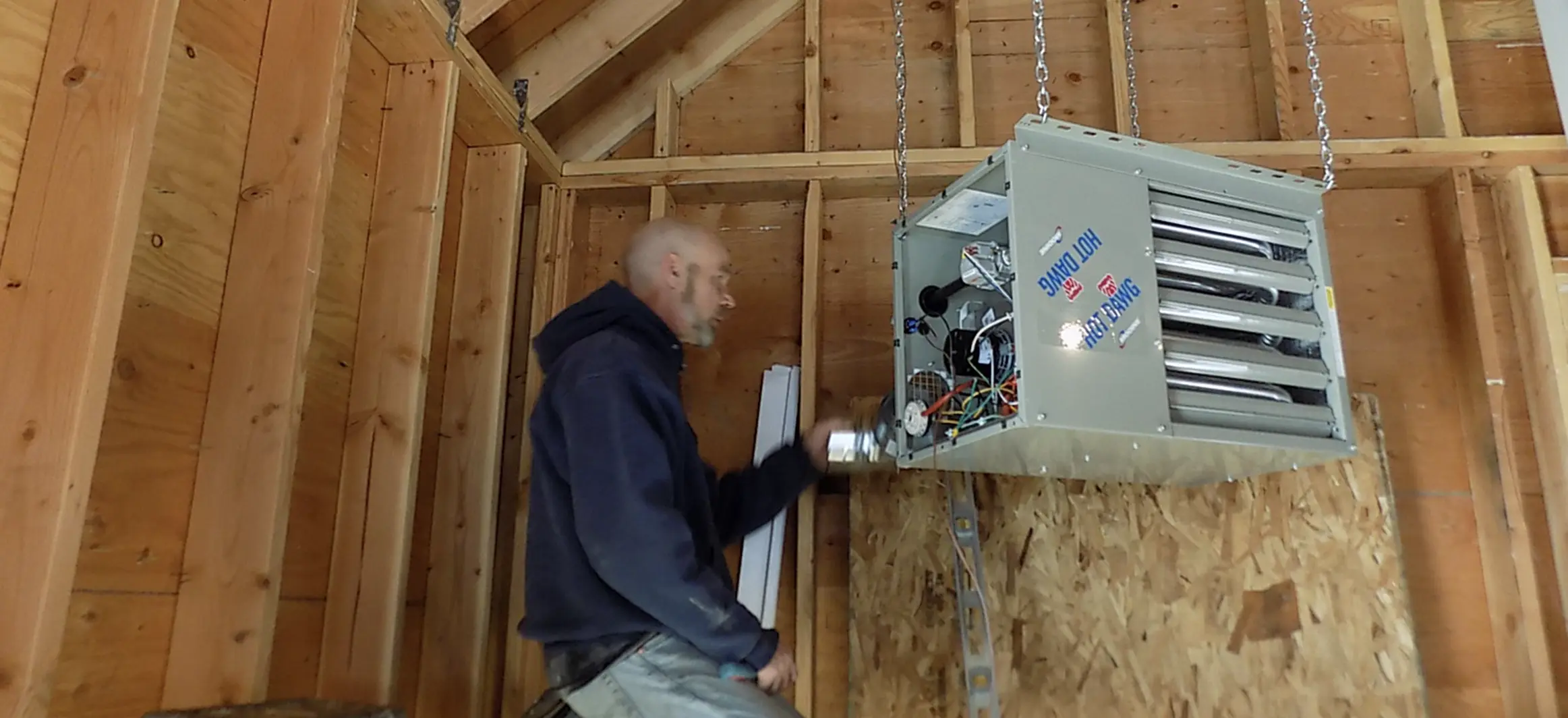
Garage Heaters
Press ‘enter’ or click to see hidden content
Whether the garage is a commercial work space, a residential space to enjoy your hobbies or just the “man cave,” you’ll want heat this winter. There are a few things to consider when selecting a garage heater to meet your needs. Residential / Commercial Garage Heaters come in different types:
- Residential Garage Heaters
- Industrial / Commercial Garage Heaters
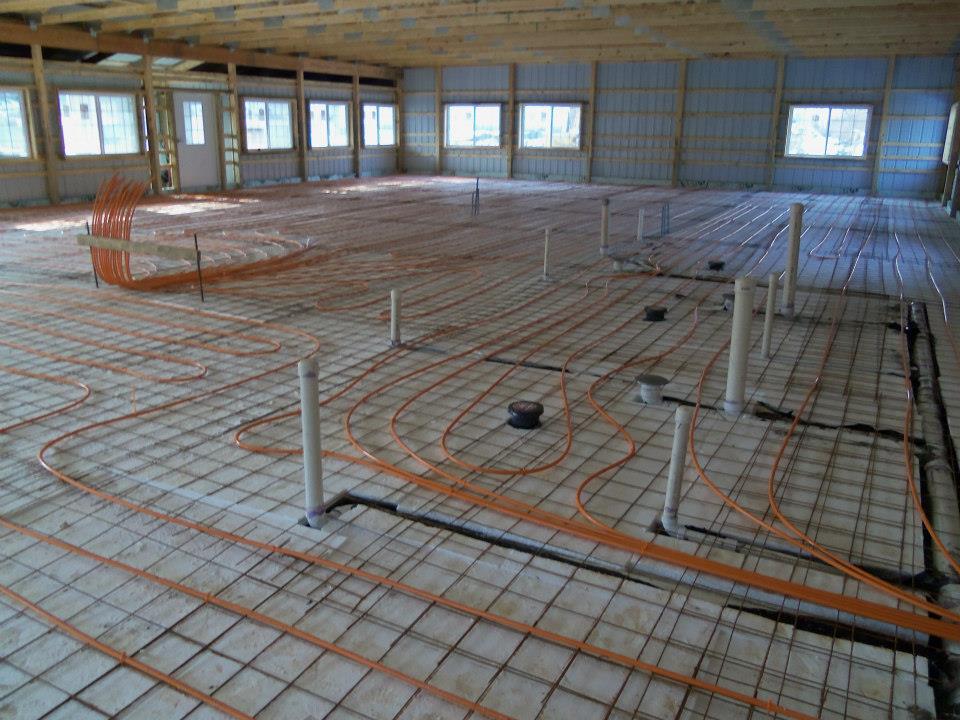
Radiant Heating
Press ‘enter’ or click to see hidden content
Radiant Heaters provide simple, spot heating to objects in the room. They work like the sun’s rays – warmth is radiated from the unit to objects or people in its path. You have to be near the heater, so they don’t warm entire garages like most electric heaters. They’re also efficient and heat more quickly than other types of heaters. They’re ideal for people who want to heat specific areas like a work station.
Learn more about radiant heating Close This Section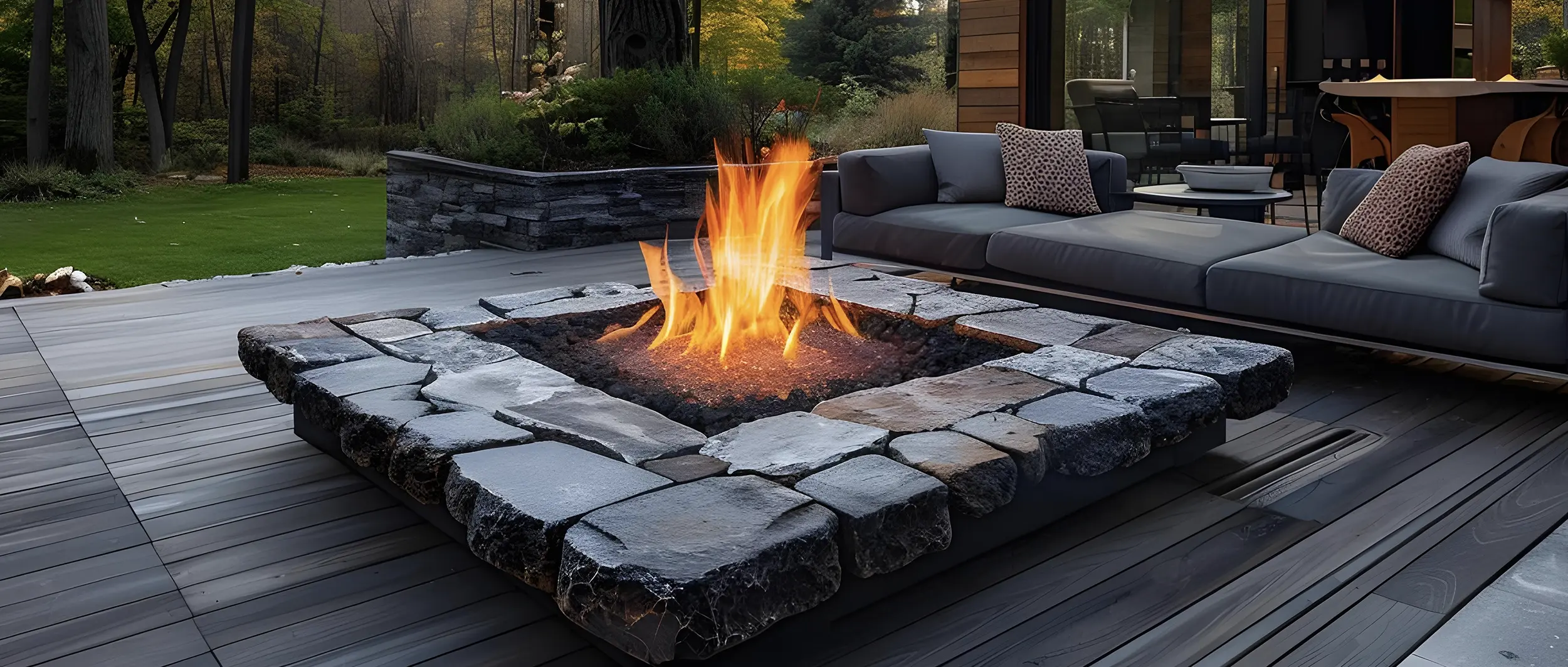
Fire Pits
Press ‘enter’ or click to see hidden content
Outdoor Fire Pits: Camp fires are a great addition to your home on a spring or summer evening… There is nothing better than sitting around the fire, enjoying a warm evening, socializing with family and friends. Everyone loves a fire but not everyone loves dealing with the effects of wood.
From gathering wood, dealing with smoke constantly blowing in your face and cleaning ashes can be a pain to deal with! With a propane outdoor fire pit / camp fire, dealing with these inconveniences are a thing of the past. Another benefit that wood doesn’t provide, your propane fire pit can even be placed on your patio or deck. CES has been installing fire pits for the almost 30 years. We have expert industry knowledge on the type of fire pit or camp fire that will best suit your home.

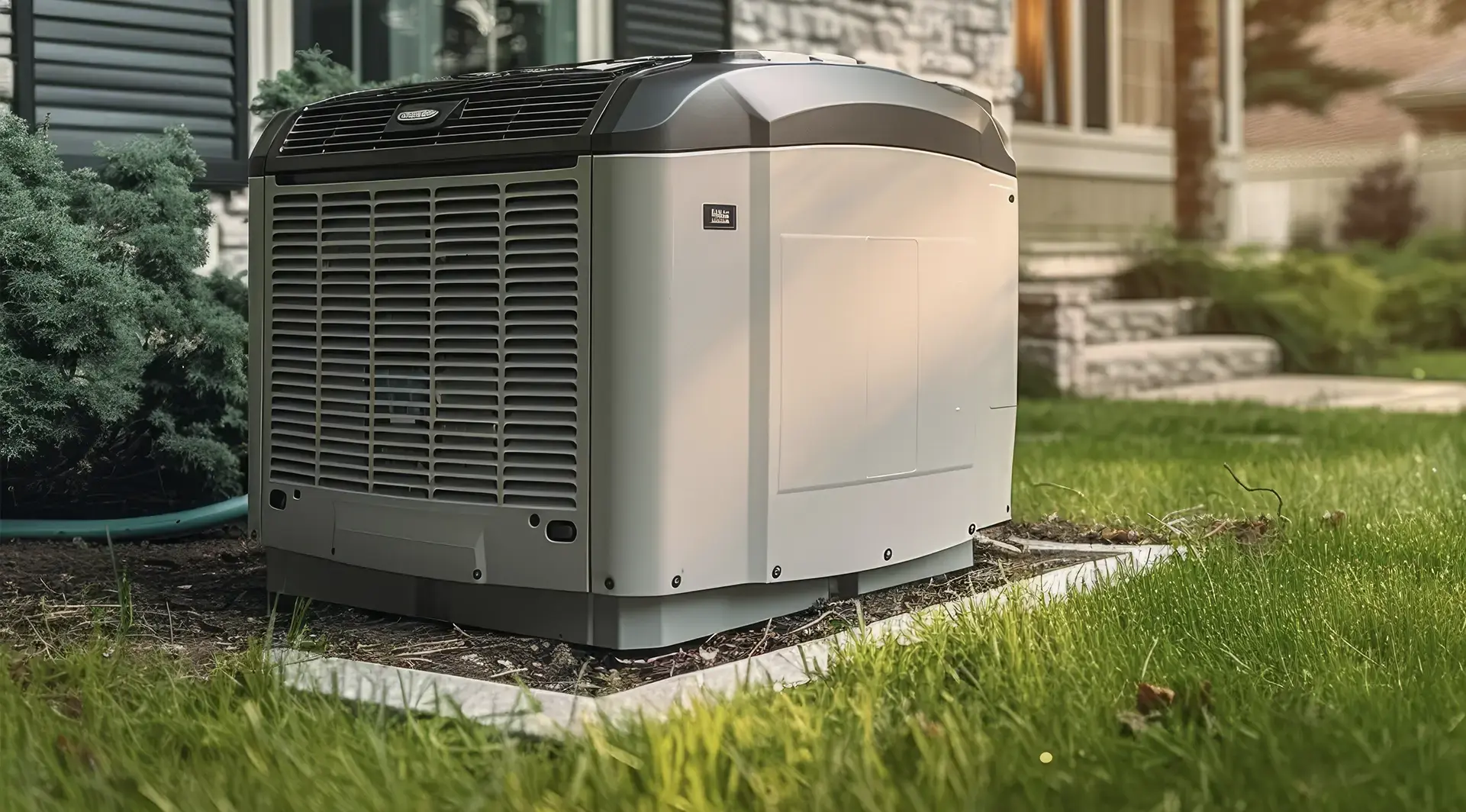
Backup Generators
Press ‘enter’ or click to see hidden content
When the power goes out, a standby generator can be man’s best friend! In a region that’s seen its share of both short and extended power outages, many have made the decision not to be left in the dark the next time the lights go out. Depending on your needs and budget, many options exist that can help prepare your home for future power outages. Whether you’re considering a portable generator for lighter-duty needs or a full standby generator system that can power your entire household during an outage, we can help. Combined Energy Services can coordinate with local electricians and contractors to assist you in preparing your home for the coping with power outages.
Combined Energy Services can:
- Size and install your propane tank
- Connect the propane gas side of the installation when your electrician is ready
- You can depend on CES to deliver propane where and when you need it – regardless of the weather

Pool Heating
Press ‘enter’ or click to see hidden content
What good is a swimming pool if the water is just too cold?
Swimming in a cold pool might be okay when you are 10 years old, but after making a large investment in your home’s pool and the very short swimming season we have here in the Northeast, many people want to get the best out of every day.
CES has been heating swimming pools of all sizes for decades with service backing every sale to make sure you get the most for your pool heater.
Enjoy your pool……Extend your swim season
Your pool and spa is a long-term investment that you, your family and friends will enjoy year after year. Now, there’s an easier way to enjoy that investment more often, more reliably and more efficiently throughout the year…the pool and spa heater.
Think about being able to use your pool or spa at the perfect comfort level even when Fall arrives…or when the first chill of Winter is felt in the wind…or in the Spring or Summer when evenings can turn chilly in a minute!
Helping you get more enjoyment from your pool or spa is the smart idea behind pool and spa heaters!
Learn more about pool heating Close This Section
